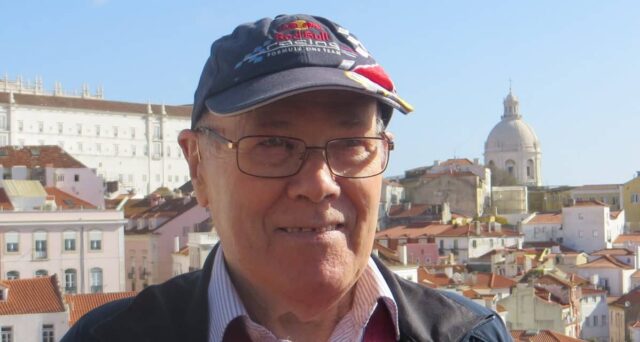Celebrating Dad’s lifelong travels
Growing up as a family of farmers meant that travel was a luxury. We didn’t always appreciate Dad giving up a week to drive us to Banff or down to Scarborough.
Our parents both travelled in Europe before they met. They made a real effort taking us five girls camping in France, introducing a different culture and decent sunshine! What better way is there to remember the many trips we had together than by celebrating Dad’s lifelong travels in our blog!
So on what would have been Dad’s 90th birthday, we’re celebrating his life-long love of travelling. Cuba and Laos/Myanmar represent trips we each took with Dad.
We honestly think Dad was a travel blogger before it became a thing! He kept copious notes of how he got to his destinations, who he met, where he went. So what better than to let his voice take the lead in this post.
Cuba
“So Dad, where do you want to go for your 80th?”
“Oh, anywhere will be fine. What about Cuba”? ” Well, that wasn’t the first place we imagined he’d suggest, but it was high on my bucket list too. Beth, our middle sister, joined us and off we set flying directly from London to Havana with Virgin Airlines. An easy direct flight of around 10 hours.
We’d booked a 10 day tour across central and western Cuba and we will publish a blog on the full trip soon. But for this post, we’re sharing Dad’s experience of Havana, Cuba, in his own words. Enjoy!
Tips for Arrival in Havana Airport
On arrival at Havana, despite all the requirements for entry into Cuba, our health insurance, currency etc. the only check was on our passport. We got a stamp on the pre-purchased tourist card and a facial photograph. All done quickly and efficiently.
Before we left the airport, we had to queue in order to change some of our English currency into convertible Cuban Pesos. After a 30-minute drive, we arrived at our hotel – Ambos Mundos, famous for counting Ernest Hemingway amongst its guests. His room is mostly as he left it, attracting many tourists.
Unique Things to Do in Cuba
Retrace Hemingway’s steps

His villa, built in 1887, was turned into a museum. Everything is left as it was was Hemingway lived here. His library holds 9,000 books!
You will find a pet cemetery in the villa gardens: the resting place for some of the 50 cats he had during his lifetime.
Hemingway was initially attracted by the Marlin fishing. However in 1938, he moved to the island, settling in the Ambos Mundos hotel in Old Havana.
Later he found a quiet villa outside the city to continue with his writing. He stayed in Cuba during the Batista period of 20 years and returned to the US in 1960.
His love of two Havana bars remains a tourist draw. Try La Bodequita for a mojito and El Floridita for a daiquiri!

Walking Tour of Old Havana
Our first morning was a walking tour of Havana Viega, the historic colonial heart of the city. It allowed us to find our bearings and discover the most important squares.
I enjoyed Plaza de Armas’s peaceful feeling, its thick tropical trees sheltering antique book stalls. Impressive palaces surround the square. The Palacio de Los Capitanes Generales, now the Museum de la Ciudad, houses a statue of Christopher Columbus.
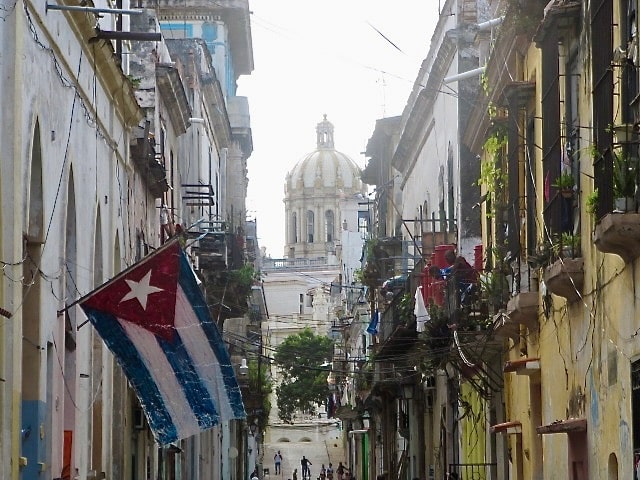
We saw the beautiful cathedral de San Cristobel, the old stock exchange and Customs house.
After walking on the cobbled streets and feeling the heat, we had our first taste of rum mojitos. Hard to believe we are here in Old Havana, on our first morning. I’m taking in the beautiful architecture, unique culture and the sight and sounds of the many musical bands.

Stroll along Calle Obisop
We walked along Calle Obisop full of shops, bars, galleries, restaurants and fresh food stalls. It is Old Havana’s main street and leads to the Plaza de Armas where we found the church of El Templete.
It was built in 1828 and has a lovely ceiba tree in front of it. Cuban respect this tree, saying both the first religious ceremony and first council meeting took place under its shade in 1519.
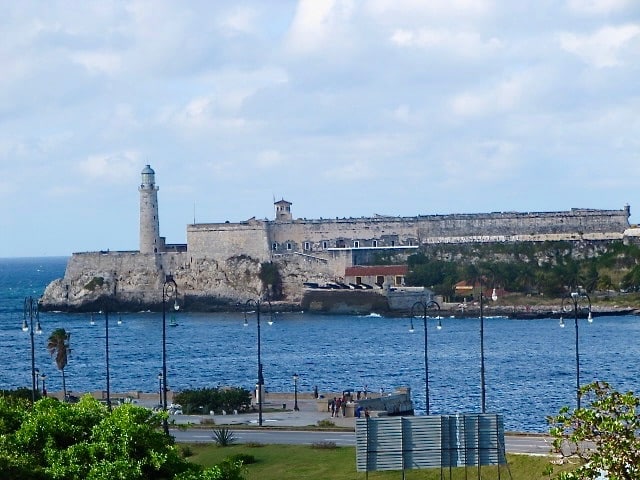
We continued exploring the Malecon – Havana’s sea front walkway or promenade. Cuban say it’s a favourite meeting point in the city. We were told it can be a real spectacle when waves come crashing over the sea wall.
On our way to a restaurant, for our evening meal, the streets were still full of people. Nobody seemed to be going anywhere. People were enjoying the bands playing, as they sat on doorway steps, smoking cigars.
Eat Dinner in a Paladar in Havana
Our dinner was at Paladar La Guarida, noted to be one of Cuba’s best restaurants. Paladars are small family eateries which run from their homes.
La Guarida is often described as the hardest place to find in Havana, and also the hardest place to find a table because of this unique atmosphere. We experienced this for ourselves when we arrived at a dark run down entrance to a shabby Havana town house, climbing 52 steps through what seemed to be a ruined building.

At the top there was a passage leading to a door, with a notice: ‘You must ring the bell’. When the door was opened, we saw straight into a very busy kitchen and from there it branched off to 3 dining rooms.
These were each beautifully decorated, with furnishings that were old Cuban style. Odd wooden chairs, a mix of glassware on the table, dinner plates that didn’t match but fitted right in. Quite extraordinary.
Visit A Cuban Food Co-operative
The next day we set off on a 20 minute drive to the east of Havana to Viega to Conde de Villanueva.
We headed to an area of green, nestled between soviet style apartment blocks and discovered Vivero Organofonico Alamar. Really a four hectare allotment!
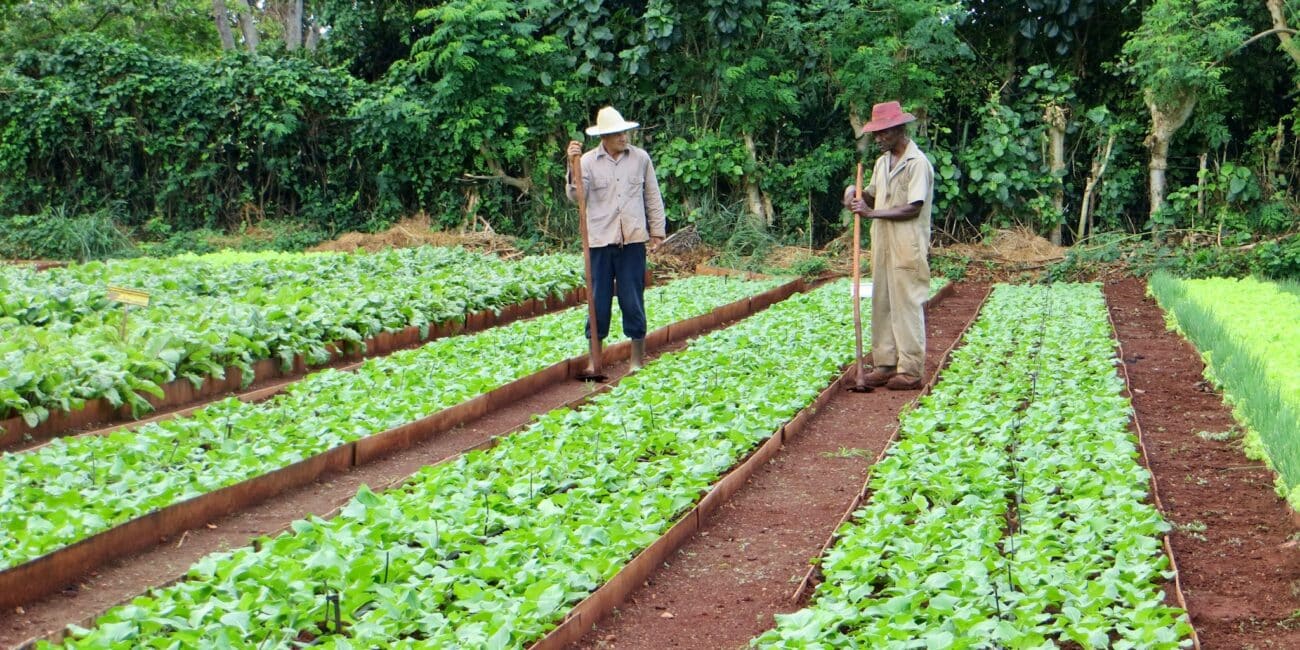
We hard first hand that collapse of the Soviet Union along with US embargo left Cubans starving. Faced with this crisis, an organic revolution began to take place all over Cuba titled the ‘Special Period’.
With imports of fertilizer, insecticides and fuel supplies all dwindling, the government realized that the only way out of the problem was through urban market gardens. They introduced Organofonicos giving land and water to co-operatives in return for a share of the crops they produced.
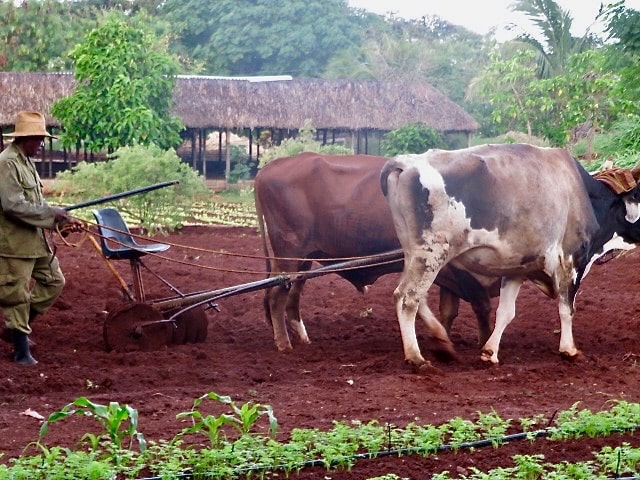
Ariel introduced us to the daughter of the man who led the project originally. She’s now the manager with 160 full time employees. The Vivero organic is one of the largest and most successful, producing some of the best produce in Cuba.
As she was telling her story, I saw a pair of oxen pulling a set of discs. It was a single row four disc set up on either side with a seat in the middle for the oxman.

Behind this were row upon row of root vegetables, vibrant green vegetables as well as familiar fruits. All were being grown for future transplanting to other sites. Vast displays of medicinal plants, including the curious Noni fruit were on site. Noni smells awful but is sweet to eat.
A small shop at the entrance was busy with locals stocking up. Beth and I sampled a sugar cane drink. We thanked our host with some good Scottish shortbread. I enjoyed this unique insight into everyday life for many people in Cuba today.
Meet a Cuban Cigar Farmer
On the way back to old Havana, we visited a few shops, buying real Cuban cigars.
We followed this with a first class lunch at Café del Griente on Plaza San Francisco overlooking the old stock exchange. Relaxed, we took a leisurely stroll back to the San Miguel Hotel.

Take a Havana Tour in a 1950s Car
That afternoon, we drove along towards the harbor in a 1957 open top Lincoln Mercury taxi looking across at the fortress Castillo del Morro ( built in 1589 ) and the nearby lighthouse, constructed of stone in 1845.
It has the original lamp, the rays of which can be seen for a radius of 20 miles every evening. At 9am, a series of cannon shots is fired by a group of young soldiers of the Revolutionary Armed Forces, dressed in 18th century uniforms.
On the other side of the Bay of Havana is the huge Cristo de la Habana, a 60 ft high white marble statue of Christ, commissioned by Basista’s wife Marta. It was completed a week before the revolution.

We stopped to view the Jose Marte Memorial in the middle of the Plaza de la Revolucion. Work on this began in 1953 on the 100th anniversary of the birth of Cuba’s national hero. It consists of a 385ft tower built with grey marble in a five star pointed shape.
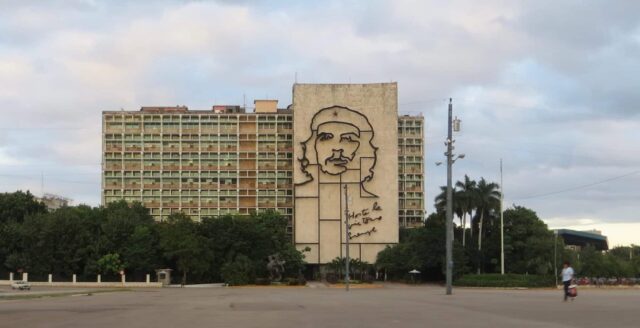
Party at the Buena Vista Social Club
For our last evening in Havana, we went to the Rum Museum and the Buena Vista Social Club. Music, dance and song play a huge part in Cuban lift, much of the rhythm originated in poor areas as a voice against slavery and segregation.
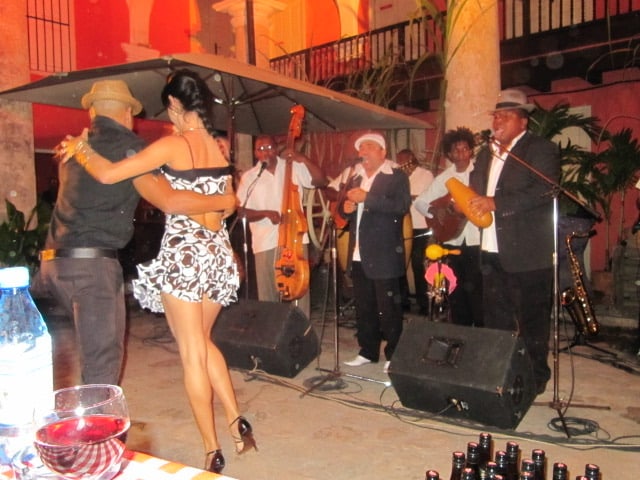
Among the Cuban musical instruments is the Tres – a small three stringed guitar and the Requito which is a high pitched guitar.
There in the Tumbadora, was a tall wooden and leather drum played by the hands, and the Bongo, consisting of two small round drums. The Claves are two wooden cylinders played by striking them against each other and the Gourd of Guira fruit which is stroked by a small stick.
The all-male band played with great exuberance and they enjoyed creating real Cuban music intertwined with dance, late into the night.
Get a glimpse of Daily Cuban Life
Walking back through cobbled streets, I observed local women working on the steps of their homes, doing linen embroidery or selling pottery items.
Cuba has much poverty and daily life is a challenge for its people. However it has an enchanting culture, people who have passion for life and make the best of their situation. Go see for yourself – it’s definitely worth a visit.”
Laos
When Dad suggested that we take a trip for my 50th birthday, I thought he meant he was coming to Suffolk. With him at almost 80, I was thinking we would leisurely potter around the Suffolk coast and have scones and cakes. Maybe a trip to Aldeburgh beach.
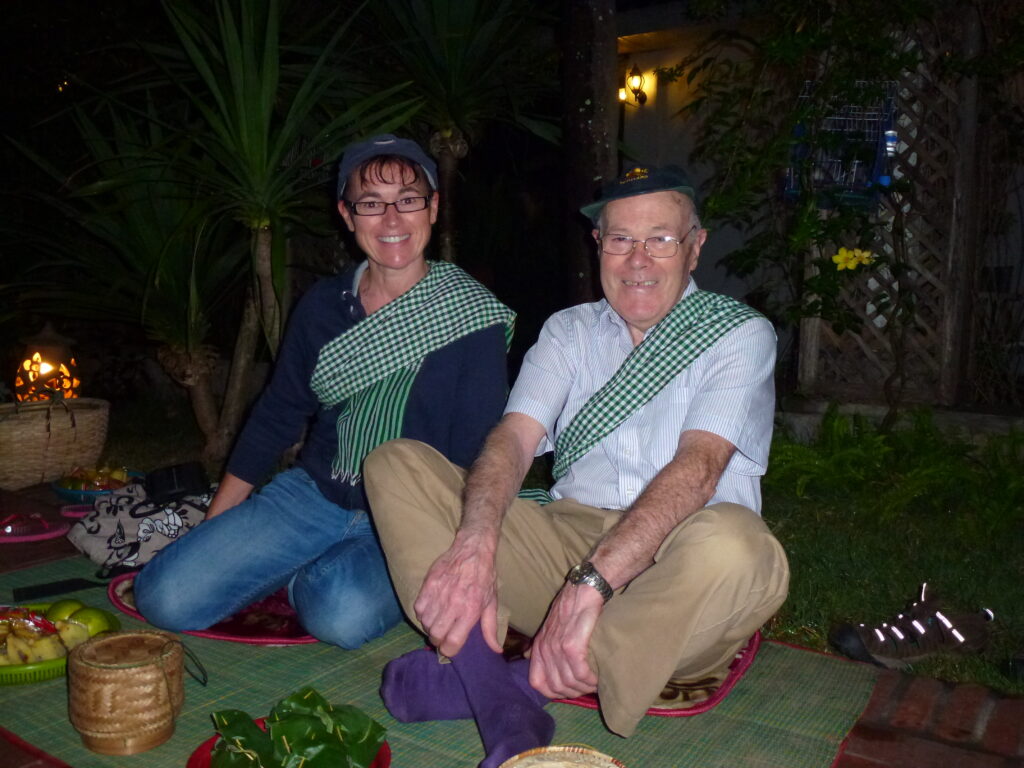
Despite booking this complete trip, including all the flights, hotels and experiences, he asked me to make the memoir notes on this trip, so I did.
Here’s my notes and our joint highlights on why visiting Laos should be part of any trip to SE Asia.
Where is Laos?
Luang Prabang is nestled by the Mekong River in Laos, a land-locked country, often overlooked in favour of Vietnam and Thailand. Arriving here felt like we were always meant to visit.
People here are always smiling, kind and so welcoming. It’s up there as one of my favourite destinations. Why? Because as well as the most wonderful people, life is just simple here. We felt no rush and yet there is so much going on as people go about daily lives.
October was a good time to visit, weather wise. Asia has a tropical climate so you can never be absolutely sure what the weather will bring but there are certain times of the year which are better to visit than others. Check Selective Asia Weather Guide – it’s a brilliant guide to the best times weather-wise to visit.
Travelling from London in late October, we arrived in Bangkok 11 hours later – the hub to many flights in Asia.
We connected to a short flight on to Luang Prabang. Our hotel 3 Nages Hotel was a gorgeous boutique hotel with only fifteen rooms. It was wonderfully located. Our waitress, Phin served delicious breakfasts every morning and shared her experiences of the town. I’m still in touch with Phin!
This city is not the capital – that’s Vientiane around 135 miles to the south.
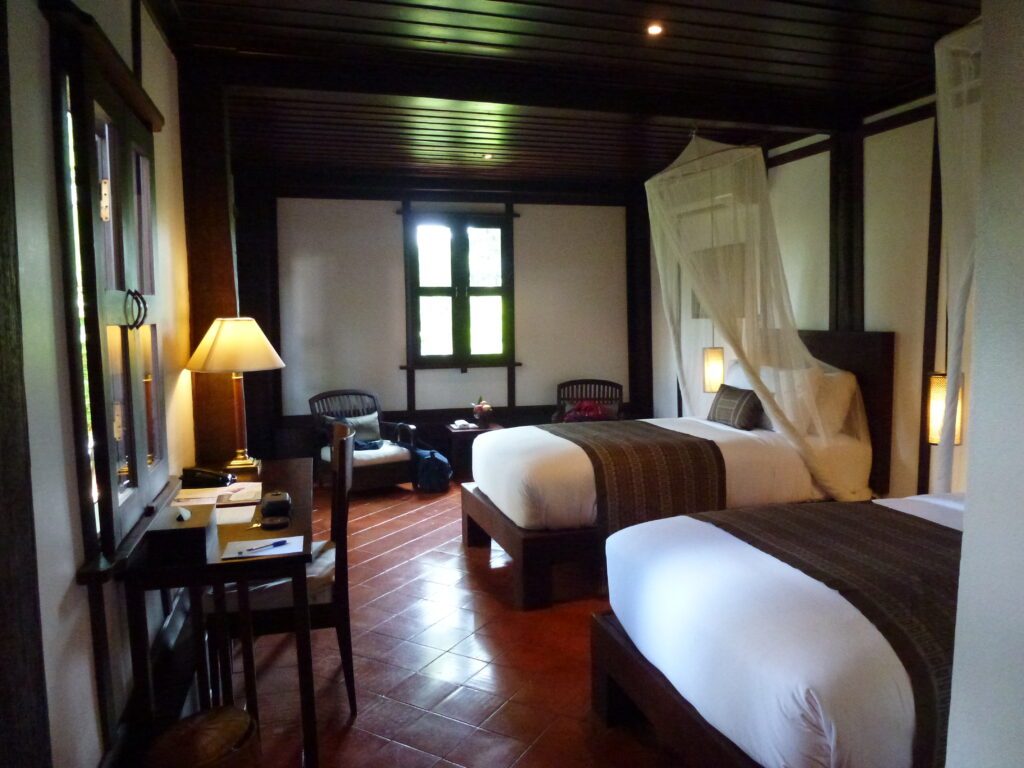
Best Things to Do In Luang Prabang
Our first day was a busy one. We visited Wat Xieng Thong, a Buddhist template from the 14th century with a massive golden Buddha inside.
We meandered down many winding streets, impossible to follow on a map. But somehow we found our way through. We took the tuk-tuk back – what fun!
As a teacher, I was interested to learn that this temple was also a school and a home (monastery) for monks, one of over 30 in the city.
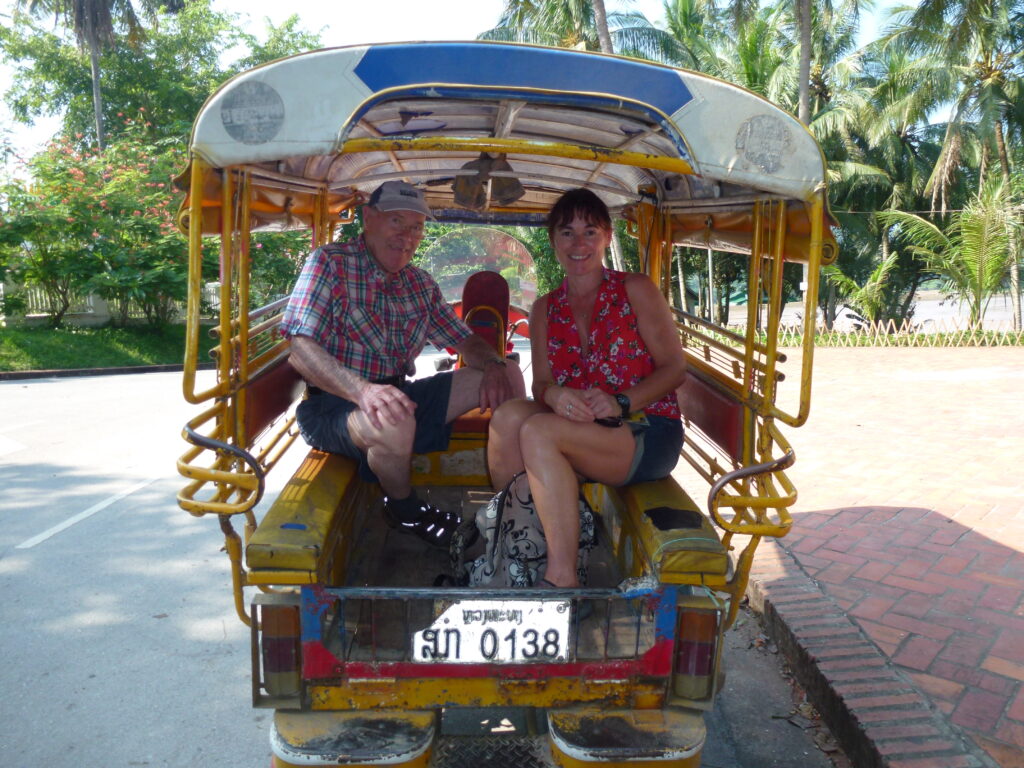
Why so many? Well, Buddhism is the dominant religionand the majority of the country’s economy is based in agriculture. Like many farming families around the planet, parents can’t afford to send their children to school.
So we learned boys must attend for a minimum of 3 months. Many choose to stay longer to continue their education. These are called novices as they have not dedicated their life to their faith. If they do, they transition to monks
Take Part in A Daily Sai Bat Ritual
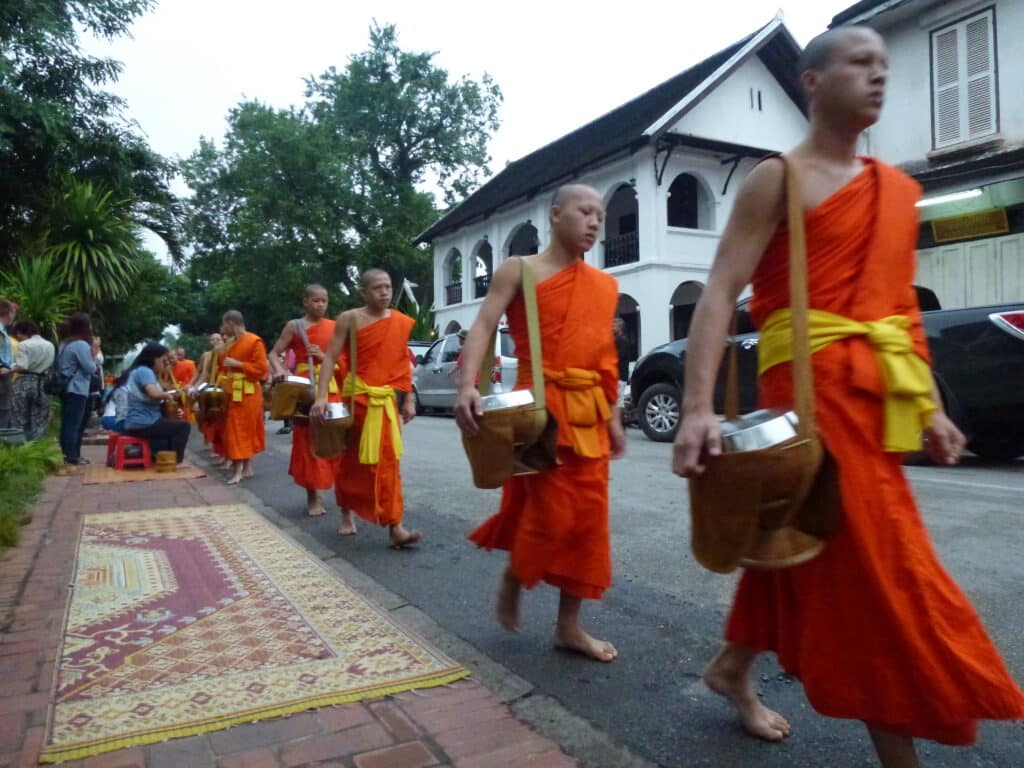
We were excited to get up at 5am because we wanted to experience and be part of the daily Sai Bat. This is a daily ritual of sunrise alms giving.
We had our offerings and like other tourists and locals we knelt down at the side of the road just by our hotel. Silently and almost regent in their saffron orange robes, hundreds of monks walked past us through the streets and gathered a small amount of food.
The monks take the collected back to the monasteries where it is shared out. The simplicity of this exchange of basic food reminded us of the power of sharing what you can with those less fortunate.
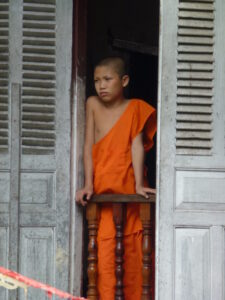
Visit Luang Prabang Night Markets
That evening we tackled the amazing night markets – Dad had raved about these to me and I was not disappointed.
Towards the end of the main street, I saw the same ‘daytime’ road transformed into rows of stalls displaying crafts. Silk paintings to beautifully embroidered bags, delicate lanterns and teak wooden boxes.
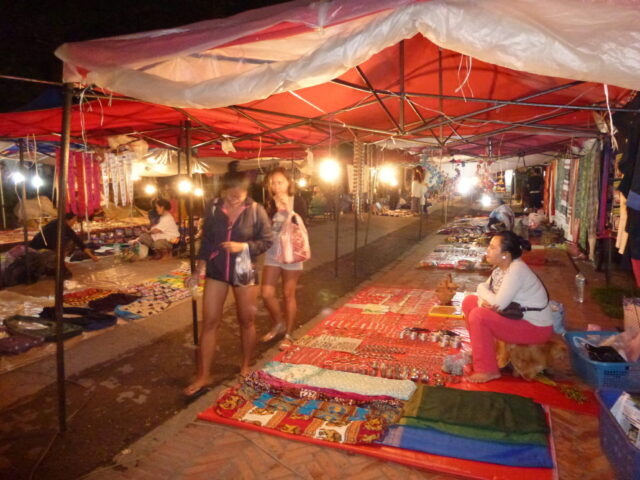
It was incredibly hard to resist these hand made goods – everything was such good quality and yet there was absolutely no pressure to buy anything at all. We enjoyed several strolls through these markets admiring wonderful artisan products.
We had also a lot of fun exploring early morning markets! People were selling food items I’d never seen before. Lots of dried fish, grains, fruits and vegetables – a riot of rich colours and smells!
Explore the Country Around Luang Prabang
Another highlight was driving out of the city to the impressive waterfalls of Kuang Si Falls. These beautiful crystal clear waters of blue and green shades were so inviting. Jude also loved this spot when she visited.
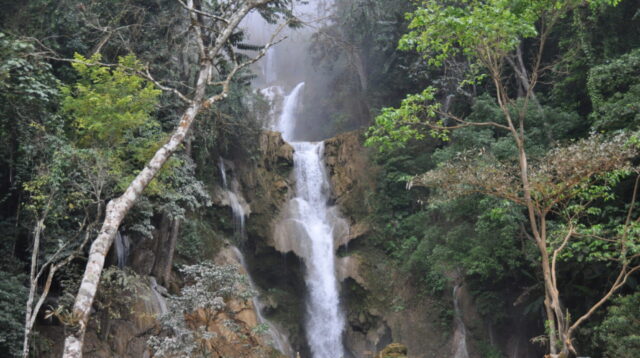
The natural beauty of Laos is hard to describe. It is untouched in large part and a big draw to hikers, climbers and those of us who love getting out in nature – places untouched by large scale tourist development.
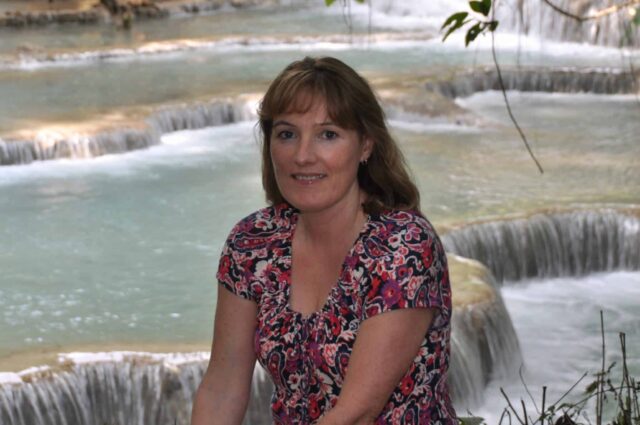
Take A Boat Across the Mekong River
As the city is on the Mekong, we decided to get on one of the small boats by the riverbank and cross over to the other side to explore and visit Wat Chompet which has a fantastic vantage point over the city.
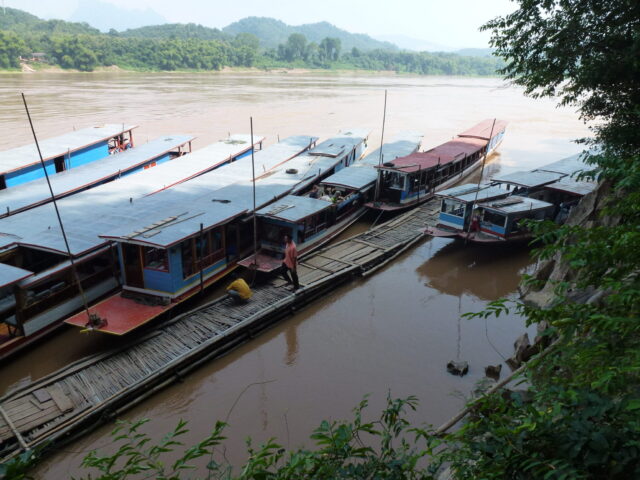
We spent most of the day on the river travelling as far as the incredible Budda caves, called Pak-ou. Even on these small boats, we had the option to have lunch – so why not, we thought.
We were treated to a delicious 4 course meal – simply served but the flavours were authentic and food cooked perfectly. Proper beansprout spring rolls – what’s not to love.
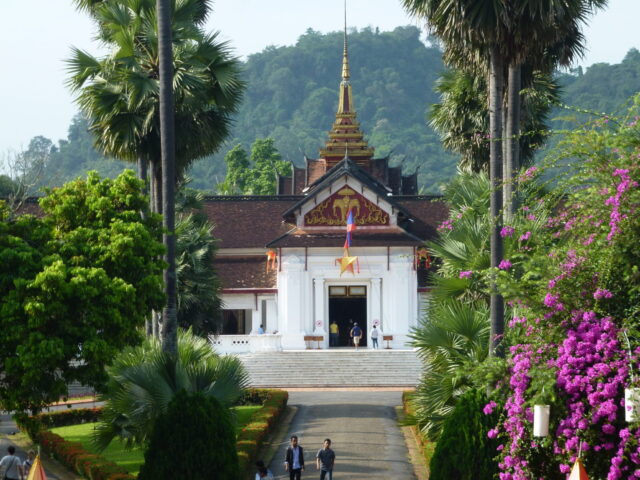
Phousie Hill is a great climb – about half an hour to walk up. Definitely worth doing as the views from the top were magnificent. I will always remember this sunset. I sat for ages watching the evening sun sink slowly behind the hills leaving an orange glow across the river.

One of our favourite things to do in Luang Prabang was to have coffee and cake. We found a fabulous Bistro Coffee Shop. We’d sit, enjoy our treats and watch the world go by. Cakes were so good. There are lots of coffee shops in the town and the coffee is superb too.
Making Lasting Friendships
I mentioned before how friendly and welcoming Laotians are. So when Dad went on his first trip here, he met a young man during this first visit working as a bartender and studying to be a lawyer.
Bill (a subscriber to our blog) – thank you ຂອບໃຈ. Dad was so interested in life and the farming angle. Bill kindly took Dad to his home to meet his family.
They had kept in touch since and I couldn’t believe that Bill wanted to meet up with Dad and I. He invited us to have dinner with himself and his fiancee, Manivanh. What a wonderful meal we had.
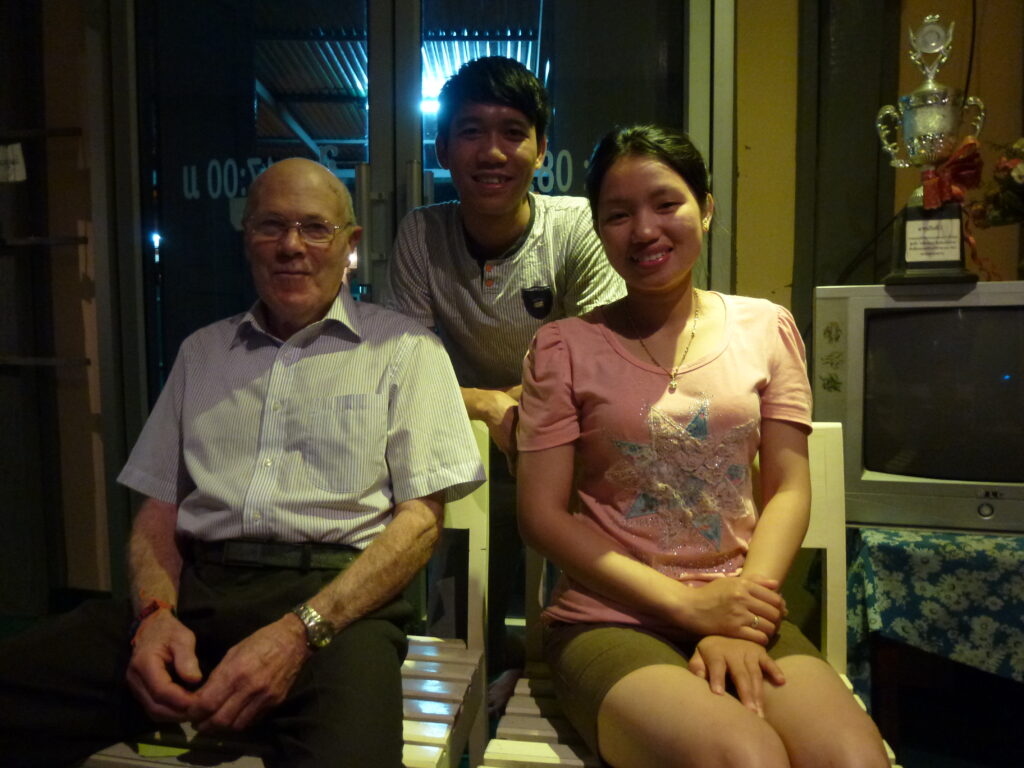
Bill invited Dad back to his wedding a few years later. It was a regret that Dad couldn’t make it but he often talked about the people of Laos and how much he admired their hard work and skills.
Myanmar (Burma)
Dad and I also spent a very good time together exploring Myanmar (Burma). It was also a country with very harsh conditions and difficult to get around, but also some incredible sights and scenes that most of us were only able to read about until recently.
I am disappointed that human rights have eroded since our visit but remain hopeful that the country will again be a place to enjoy visiting in peace.
Highlights of our trip there included the fast-paced city of Yangon, the Shewedagon Pagoda, the incredible arrays of Buddhas within the temples; the vibrant Bogyoke market. Outside of the city, the pottery town of Twante was so interesting.

We found life here a world away from our own. We spent time at traditional villages watching potters create pots of all shapes and sizes sitting bare feet on the ground with giant kilns smoking continuously.
The small thatched houses built on stilts were home to many in the family. Our guide was excellent that day and gave us a superb insight into life in rural Myanmar.
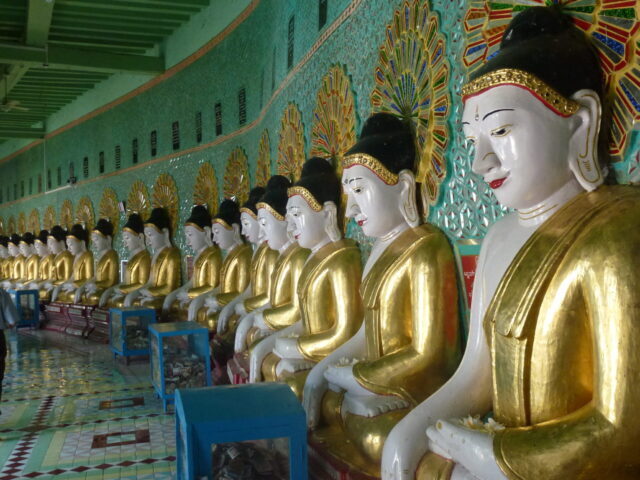
We also explored the city of Mandalay and surrounding villages. Dad being a wood turner loved watching the many crafts people at work. I loved the views from Saigang Hill. We peeled ourselves away to visit the ancient city of Inwa by horse and cart and saw a traditional monastery.
Without doubt, the highlight of this trip was watching another sunset – this time at the U Bein Bridge, the longest teakwood bridge in the world. I was star struck! It was just the most stunning backdrop – if you go anywhere in Myanmar – go here!
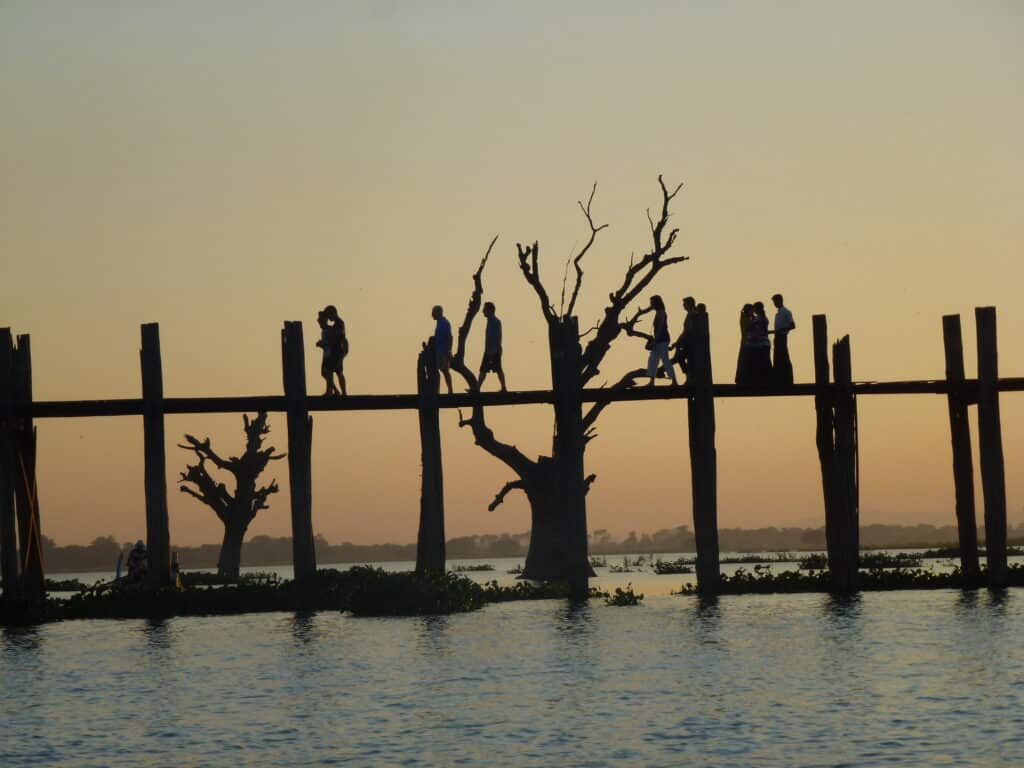

Celebrating Dad’s lifelong travels
What we learnt from dad was never let it be said that you’re too old to travel or try new experiences – there’s a great world out there.
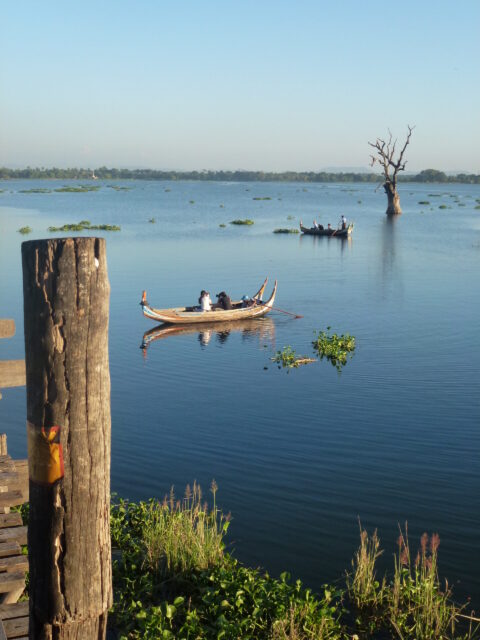
So in the words of our dad it seems only fitting to finish with what he always said to us: ‘Once a year, go someplace you’ve never been before’. Well Dad, don’t worry -we’re certainly doing that!
Dad loved his trips and especially South Africa to visit our sister Katie. If you are looking for itinerary ideas our Sensational South Africa Itinerary is full of ‘local’ tips and secrets especially around Kwazulu-Natal and Cape Town.

